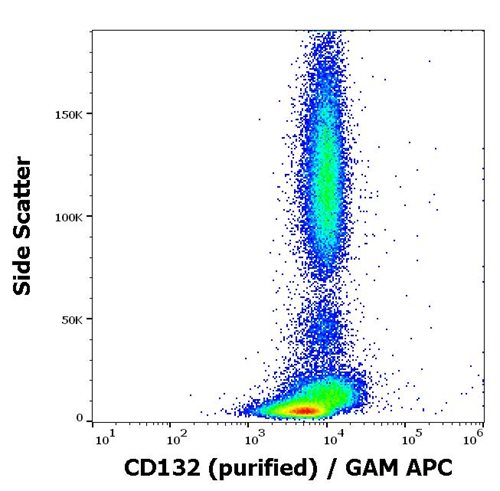Anti-CD5 / T1 Monoclonal Antibody (Clone:MEM-32)
Shipping Info:
For estimated delivery dates, please contact us at [email protected]
| Format : | Purified |
| Amount : | 0.1 mg |
| Isotype : | Mouse IgG1 |
| Purification : | Purified by protein-A affinity chromatography |
| Storage condition : | Store at 2-8°C. Do not freeze. |
CD5 antigen (T1; 67 kDa) is a human cell surface T-lymphocyte single-chain transmembrane glycoprotein. CD5 is expressed on all mature T-lymphocytes, most of thymocytes, subset of B-lymphocytes and on many T-cell leukemias and lymphomas. It is a type I membrane glycoprotein whose extracellular region contains three scavenger receptor cysteine-rich (SRCR) domains.The CD5 is a signal transducing molecule whose cytoplasmic tail is devoid of any intrinsic catalytic activity. CD5 modulates signaling through the antigen-specific receptor complex (TCR and BCR). CD5 crosslinking induces extracellular Ca++ mobilization, tyrosine phosphorylation of intracellular proteins and DAG production. Preliminary evidence shows protein associations with ZAP-70, p56lck, p59fyn, PC-PLC, etc. CD5 may serve as a dual receptor, giving either stimulatory or inhibitory signals depending both on the cell type and development stage. In thymocytes and B1a cells seems to provide inhibitory signals, in peripheral mature T lymhocytes it acts as a costimulatory signal receptor. CD5 is the phenotypic marker of a B cell subpopulation involved in the production of autoreactive antibodies.Disease relevance: CD5 is a phenotypic marker for some B cell lymphoproliferative disorders (B-CLL, Hairy cell leukemia, etc.). The CD5+ popuation is expanded in some autoimmune disorders (Rheumatoid Arthritis, etc.). Herpes virus infections induce loss of CD5 expression in the expanded CD8+ human T cells.
ELISA: The antibody MEM-32 can be used in the Sandwich ELISA as the capture antibody in pair with the detection antibody CRIS1.
Immunohistochemistry (paraffin sections): Recommended dilution: 20 μg/ml; positive tissue: spleen.
Flow cytometry: Recommended dilution: 2 μg/ml.
Western blotting: Laurylmaltoside lysing buffer; non-reducing conditions; recommended dilution: 1-2 μg/ml.
For Research Use Only. Not for use in diagnostic/therapeutics procedures.
| Subcellular location: | Cell membrane |
| Post transnational modification: | Phosphorylated on tyrosine residues by LYN; this creates binding sites for PTPN6/SHP-1. |
| BioGrid: | 107359. 14 interactions. |
|
There are currently no product reviews
|


















.png)











